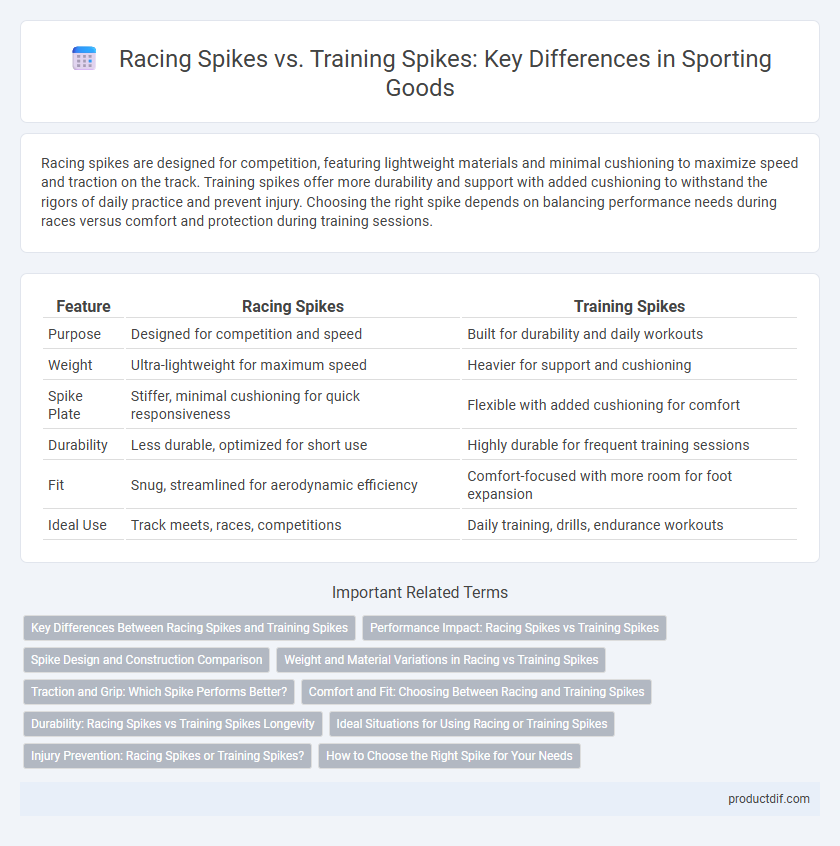Racing spikes are designed for competition, featuring lightweight materials and minimal cushioning to maximize speed and traction on the track. Training spikes offer more durability and support with added cushioning to withstand the rigors of daily practice and prevent injury. Choosing the right spike depends on balancing performance needs during races versus comfort and protection during training sessions.
Table of Comparison
| Feature | Racing Spikes | Training Spikes |
|---|---|---|
| Purpose | Designed for competition and speed | Built for durability and daily workouts |
| Weight | Ultra-lightweight for maximum speed | Heavier for support and cushioning |
| Spike Plate | Stiffer, minimal cushioning for quick responsiveness | Flexible with added cushioning for comfort |
| Durability | Less durable, optimized for short use | Highly durable for frequent training sessions |
| Fit | Snug, streamlined for aerodynamic efficiency | Comfort-focused with more room for foot expansion |
| Ideal Use | Track meets, races, competitions | Daily training, drills, endurance workouts |
Key Differences Between Racing Spikes and Training Spikes
Racing spikes are designed for competition, featuring lightweight materials and aggressive spike plates that maximize traction and propulsion on the track. Training spikes offer more cushioning, durability, and support to withstand the higher mileage and varied workouts typical in practice sessions. The key differences lie in weight, spike configuration, and durability, with racing spikes prioritizing speed and training spikes emphasizing comfort and longevity.
Performance Impact: Racing Spikes vs Training Spikes
Racing spikes deliver maximum performance impact through their ultra-lightweight design and aggressive spike configuration, enhancing traction and speed during competitions. Training spikes prioritize durability and comfort, providing sufficient grip for repetitive workouts without sacrificing foot support. Choosing the right spikes directly influences sprint efficiency and injury prevention by aligning spike features with athletic demands.
Spike Design and Construction Comparison
Racing spikes feature lightweight, aerodynamic plates with fewer, sharper spikes for maximum traction and speed on track surfaces, while training spikes prioritize durability and comfort with thicker plates and more flexible spikes designed to withstand repetitive use during workouts. Racing spikes often use advanced materials like carbon fiber to reduce weight and enhance propulsion, whereas training spikes incorporate cushioning elements and reinforced uppers to support longer training sessions. The spike length on racing shoes is generally longer for enhanced grip during competitive events, contrasting with shorter, more robust spikes on training shoes to balance traction and longevity.
Weight and Material Variations in Racing vs Training Spikes
Racing spikes are designed with ultra-lightweight materials such as carbon fiber and advanced synthetic fabrics to maximize speed and reduce fatigue during competition. Training spikes prioritize durability and comfort, often using heavier, more robust materials like reinforced mesh and rubber to withstand frequent use and provide better support. The significant weight difference between the two types directly impacts performance, making racing spikes the preferred choice for competitive events while training spikes offer reliability for everyday practice.
Traction and Grip: Which Spike Performs Better?
Racing spikes prioritize maximum traction with aggressive, often metal-tipped spikes designed for explosive speed on track surfaces, providing superior grip during sprints and sharp turns. Training spikes feature shorter, fewer spikes made from durable materials to balance traction with comfort and versatility for varied workouts and surfaces. Racing spikes generally outperform training spikes in grip and traction, making them ideal for competition but less suitable for everyday training due to decreased comfort and spike wear.
Comfort and Fit: Choosing Between Racing and Training Spikes
Racing spikes prioritize lightweight design and minimal cushioning to maximize speed but may sacrifice comfort for shorter durations. Training spikes offer enhanced padding and support, promoting better fit and comfort essential for extended practice sessions. Athletes should select spikes based on activity intensity and the importance of foot stability during use.
Durability: Racing Spikes vs Training Spikes Longevity
Training spikes are designed with durable materials and reinforced construction to withstand the wear and tear of regular practice sessions, offering superior longevity compared to racing spikes. Racing spikes prioritize lightweight design and minimal cushioning for peak performance, resulting in reduced durability and a shorter lifespan under frequent use. Athletes seeking long-lasting footwear for daily training benefit more from the rugged build of training spikes versus the delicate nature of racing spikes.
Ideal Situations for Using Racing or Training Spikes
Racing spikes are designed for competitive events, ideal for sprinting on track surfaces where maximum speed and minimal weight are crucial, often used in races ranging from 100 meters to 10,000 meters. Training spikes prioritize durability and comfort, suitable for daily workouts and longer practice runs, providing support and stability needed to build endurance while reducing injury risk. Selecting between racing and training spikes depends on balancing performance enhancement during competitions with the need for reliable, comfortable footwear in training sessions.
Injury Prevention: Racing Spikes or Training Spikes?
Training spikes offer enhanced cushioning and support compared to racing spikes, significantly reducing the risk of injury during high-volume workouts. Racing spikes prioritize lightweight design and minimal sole thickness for speed, which can increase stress on muscles and joints if used extensively in training. Selecting training spikes for regular practice ensures better shock absorption and stability, thereby preventing overuse injuries common among athletes.
How to Choose the Right Spike for Your Needs
Selecting the right spikes depends on your athletic goals and training intensity, with racing spikes designed for lightweight speed and competition, featuring minimal cushioning and aggressive traction. Training spikes offer more durability and cushioning for daily workouts, providing support to reduce injury risk during high-volume use. Evaluate factors like track type, event distance, and foot comfort to determine whether racing or training spikes best enhance your performance and safety.
Racing spikes vs Training spikes Infographic

 productdif.com
productdif.com